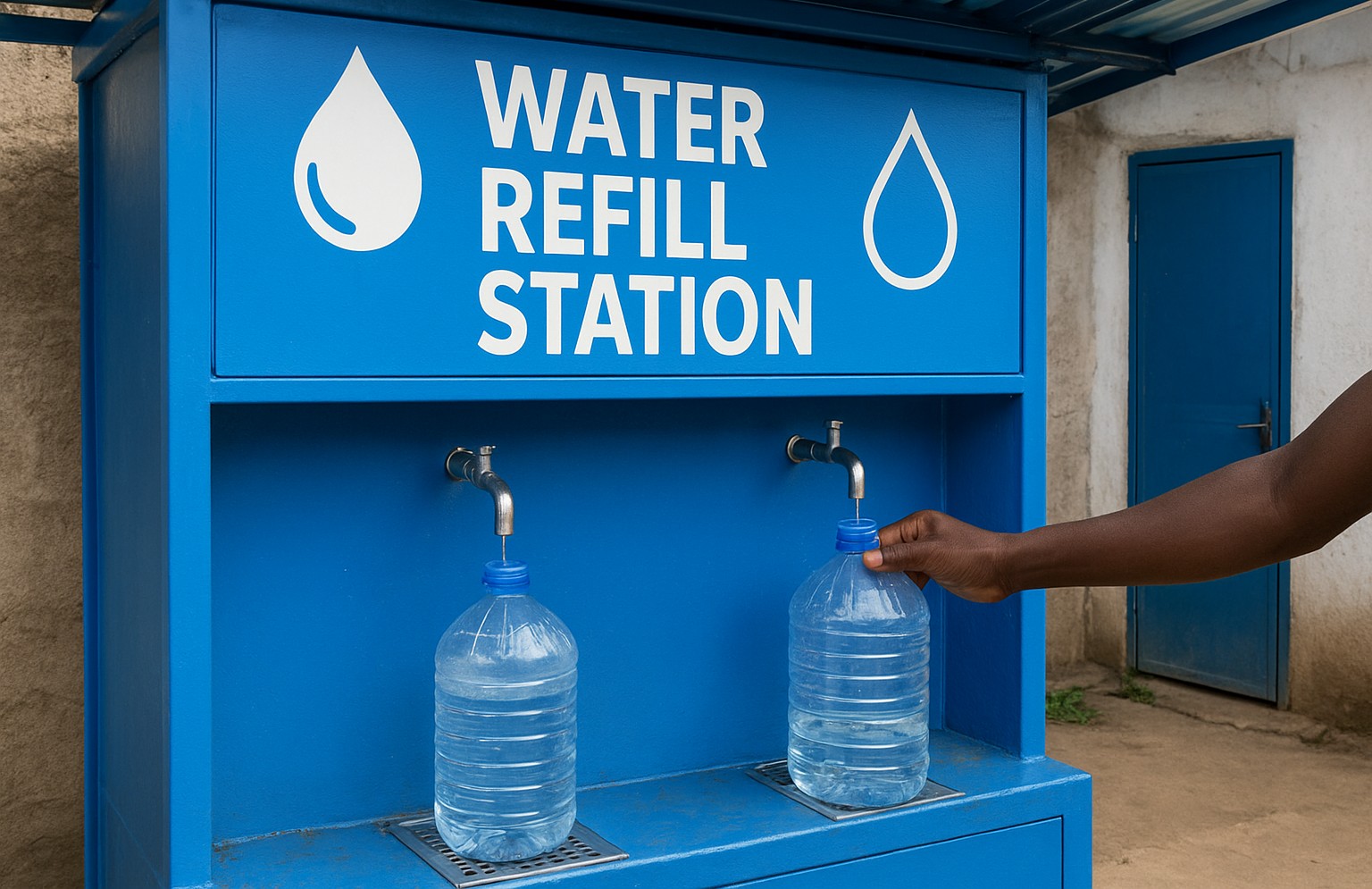

Titus Morebu
Author
How to Launch a Profitable Water Refill Station in Kenya 💧
Learn how to set up a water refill business in Kenya: from permits, equipment, water safety, and marketing to profit strategies — your step-by-step guide.
Introduction
Water is life — and in Kenya, access to safe drinking water remains a pressing need in many areas. Setting up a water refill (or “water kiosk”) station can be not only a socially impactful venture but also a viable business opportunity. This guide walks you through how to start a water refill station in Kenya — from planning and compliance to operations and growth. 💼
Why a Water Refill Station is a Good Business Idea
- High demand: Many communities lack consistent access to clean water, making refill stations valuable.
- Recurring revenue: Customers come back repeatedly to refill containers.
- Low waste footprint: Encourages reuse of containers, reducing plastic bottle waste.
- Scalable: You can start small (1–2 taps) and expand as demand grows.
Step 1: Market Research & Feasibility
Before investing, understand your target market and competitors.
- Identify neighborhoods, estates, markets, schools, or transit hubs with limited access to clean water.
- Survey potential customers to learn their refill habits, price sensitivity, and preferred container sizes.
- Visit existing refill stations: see their pricing, volumes, and customer flows.
- Estimate daily demand and project whether a single or multi-tap setup is justified.
Step 2: Business Model & Scale
Decide how you will run the station.
- Independent model: You procure the equipment, manage operations, source water, and control branding.
- Franchise/collaboration: Partner with an existing water brand or supplier who may provide equipment, training, and bulk water supply.
- Hybrid model: Start with your own brand using water purchased from a certified bulk supplier, and eventually shift to your own source as you grow.
Step 3: Legal Requirements & Regulation
Operating a water refill station legally in Kenya requires compliance with multiple bodies and standards.
Water Vending Guidelines (WASREB)
The Water Services Regulatory Board (WASREB) has guidelines that regulate water vending systems, risk controls, registration, and pricing. You must comply with water quality, safety, and reporting requirements under these guidelines.
County & Local Permits
- Obtain a Single Business Permit from your local county government — cost varies (often KSh 5,000 to KSh 20,000 per year).
- Register your business legally (e.g. as a sole proprietor, partnership, or limited company).
- Get health inspection and certification from local public health authorities.
Kenya Bureau of Standards (KEBS)
Your water and processes must meet KEBS drinking water standards (e.g. KS EAS 153) and hygiene codes (e.g. KS 459). You may need KEBS certification and periodic testing of water quality.
Other Environmental & Water Use Permits
- If you plan to abstract groundwater (borehole) or pipe raw water, you may need approval from the Water Resources Management Authority.
- Ensure compliance with environmental regulations (e.g. in terms of waste disposal, effluent handling, and local zoning).
Step 4: Source & Treat Your Water
Water Supply Options
- Bulk purchase from a certified water supplier or municipal utility.
- Tap into a treated municipal connection.
- Use your own borehole (if water quality and regulation allow).
Treatment & Purification Systems
Ensure you install a system capable of delivering safe potable water. Key technologies include:
- Pre-filtration (sediment, carbon filters)
- Reverse Osmosis (RO) membranes
- UV disinfection or ozone treatment
- Polishing filters and post treatment to balance pH
- Proper storage & recirculation to avoid stagnation
Quality Assurance & Testing
- Test for microbial (E. coli, total coliforms) and chemical contaminants regularly.
- Maintain logs of water quality tests and make them available to regulators.
- Have a water safety plan and contingency protocols in case contamination is detected.
Step 5: Choose Equipment & Setup
Refill Station Hardware
Equipment will vary by scale. Typical elements include:
- Water dispensing taps (1-tap, 2-tap, 3-tap systems) — entry models often start around KSh 100,000
- Pumps, pressure vessels, booster systems
- Storage tanks (clean water, raw water)
- Plumbing, pipes, valves, fittings
- Electricity or solar backup if needed
- Control panels, flow meters, digital displays, or coin/card payment systems
Layout & Facility Design
- Ensure space for customers to queue comfortably
- Provide shade, drainage, easy access
- Design separate zones for raw water, treatment, storage, and dispensing
- Plan for future expansion (extra taps, capacity)
Step 6: Location & Logistics
- Choose high foot traffic zones — near estates, transit hubs, markets, or schools.
- Ensure easy supply access (for water delivery or raw water) and easy customer access.
- Check competition density and pricing in the area.
- Consider visibility, security, utility access (water, electricity).
Step 7: Financial Planning & Pricing
Map your costs and revenue projections carefully.
- Initial capital: equipment, installation, renovation, permits.
- Operating costs: electricity, filter replacements, labor, maintenance, water procurement, testing.
- Depreciation and contingency buffer for repairs.
- Set prices per liter or container with margins — ensure you cover all costs and remain competitive.
- Consider bundled packages or subscription models for regular customers.
Step 8: Operations & Quality Control
- Train staff in hygiene, equipment maintenance, customer service.
- Replace filters and membranes as per schedule.
- Monitor flow rates, pressure, leakages, and system alarms.
- Maintain cleanliness at dispensing points; schedule daily and weekly sanitizing.
- Implement customer feedback and complaint handling systems.
Step 9: Branding, Marketing & Customer Trust
- Choose a memorable name and logo; brand your station professionally.
- Use signage, banners, and local posters.
- Offer introductory discounts or free refills to first users.
- Educate customers about your purification process — transparency builds trust.
- Use social media, WhatsApp groups, community outreach to spread the word.
Step 10: Growth & Scaling
- Add more taps as demand grows.
- Open satellite refill points (kiosks) in nearby communities.
- Expand into water packaging or bottled water once your reputation is solid.
- Partner with delivery services to supply water to homes and offices.
- Implement data systems (sales, customers, water use) to guide decisions.
Challenges & Risk Mitigation
No business is risk-free. Key considerations include:
- Water quality lapses: always keep backup plans and rigorous testing.
- Equipment failure: stock spare parts; sign maintenance contracts.
- Regulatory crackdowns: stay compliant, renew licences, stay updated with new regulations.
- Competition and price pressure: differentiate via quality, service, transparency.
- Supply disruptions: keep backup water sources or storage buffers.
Conclusion
Launching a water refill station in Kenya is an exciting and socially impactful venture. With careful planning, strict adherence to regulation, effective operations, and trust-building, you can build a sustainable enterprise that benefits your community and rewards you financially. Start small, stay consistent, and grow with your customers’ needs. 🌍
For more guidance on water regulations and water safety standards, refer to relevant government agencies and standards bodies.
Gallery

Related Articles
3 articles
How to Launch a Profitable Phone Accessories Shop in Kenya 📱
Want to start a phone accessories shop in Kenya? Learn step-by-step how to set up, source, market and grow your store for sustainable profits.

How to Launch a Successful Barber Training School in Kenya: A Step-by-Step Guide 💈
Start your own barber training school in Kenya with this actionable guide — from licensing and curriculum design to marketing and operations — and build a reputable institution.

Profitable Fish Farming Ideas in Kenya: Top Opportunities & Smart Strategies
Explore the most viable, high-return fish farming ventures in Kenya, with modern methods, species ideas, cost breakdowns and growth tips for success.